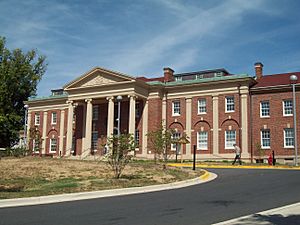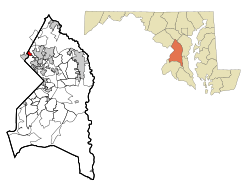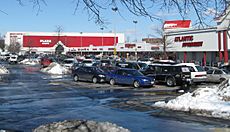Langley Park, Maryland facts for kids
Quick facts for kids
Langley Park, Maryland
|
|
|---|---|

Langley Park Mansion in September 2010
|
|

Location of Langley Park in Prince George's County, Maryland
|
|
| Country | |
| State | |
| County | |
| Area | |
| • Total | 0.99 sq mi (2.58 km2) |
| • Land | 0.99 sq mi (2.57 km2) |
| • Water | 0.00 sq mi (0.00 km2) |
| Elevation | 151 ft (46 m) |
| Population
(2020)
|
|
| • Total | 20,126 |
| • Density | 20,247.48/sq mi (7,816.00/km2) |
| Time zone | UTC−5 (Eastern (EST)) |
| • Summer (DST) | UTC−4 (EDT) |
| ZIP Codes |
20783, 20903
|
| Area code(s) | 301, 240 |
| FIPS code | 24-45525 |
| GNIS feature ID | 0597659 |
Langley Park is a community in Maryland, United States. It's not a city, but a "census-designated place" (CDP). This means it's an area the government tracks for population and statistics. Langley Park is located in Prince George's County, Maryland, right next to Montgomery County, Maryland. It's also inside a large highway loop called the Capital Beltway. In 2020, about 20,126 people lived there.
Contents
History of Langley Park
The name "Langley Park" comes from a large estate established in 1923. It was created by the McCormick-Goodhart family. This family connected two important lines: the McCormick family from Chicago (known for Cyrus McCormick) and the Goodhart family from Kent, England.
The Langley Park Estate and Mansion
The McCormick-Goodhart family named their 540-acre (2.2 km2) estate "Langley Park" after their family home in England. In 1924, they built a huge, 18,000-square-foot (1,700 m2) mansion with 28 rooms. It was designed in the Georgian Revival style by architect George Oakley Totten, Jr.. This mansion, located at 8151 15th Ave, is still a famous landmark in the community.
In 2009, an organization called CASA of Maryland bought the mansion. They turned it into their main office and a US$31 million Multicultural Community Center. The mansion was added to the National Register of Historic Places in 2008 because of its historical importance.
Early Community Development
During the late 1930s and early 1940s, the Langley Park estate was a social hub. Leander McCormick-Goodhart, a son of the original owners, worked for the British embassy. This led to many events related to the British embassy being held at the estate, including Cricket games and a British Relief Country Fair in 1941.
After World War II, the estate was divided into smaller pieces for development. It became a planned community with different types of homes.
- In 1949, a large apartment complex called Langley Park Apartments was built. It had 1,542 "garden apartments" (apartments with access to outdoor space).
- Around the same time, M.T. Broyhill and Sons started building 600 single-family homes. These homes were completed by 1951.
- In 1951, plans were made for more apartments and a large shopping center.
The last part of the original estate was developed in 1963. This 25-acre (100,000 m2) area, which included the manor house, was bought by developers. They built the 400-unit Willowbrook Apartments there. The mansion itself was used as the Willowbrook Montessori School until the early 1990s.
Langley Park School and Population Changes
The Langley Park Elementary School, now called Langley Park-McCormick School, opened in 1950. In 1988, a descendant of the estate owners, Leander McCormick-Goodhart, donated $10,000 to the school. At that time, many students at the school were from other countries. About 60 percent of the 610 students were foreign-born, coming from 45 different countries and speaking 27 languages.
In 1955, Langley Park was growing very fast. It was known as "the fastest growing trade area in Metropolitan Washington." Many young couples with families moved there because housing was affordable. For a while, it was a community mainly of white middle-class families, many of whom were Jewish. However, the Jewish community started to decline in the 1960s.
After desegregation, more African Americans moved into Langley Park during the 1970s. Many white residents moved to other suburbs. The number of people who spoke Spanish also grew. By 1980, 13.4 percent of the population spoke Spanish as their first language.
During the 1980s, many immigrants from Hispanic and Caribbean countries moved to Langley Park. These included people from El Salvador, Mexico, Guatemala, Colombia, Bolivia, Peru, and Jamaica. Immigrants from Asian and African countries like Vietnam, India, Ethiopia, and Nigeria also settled there. Langley Park was attractive to immigrants because it had affordable housing for families. This growth in diverse populations was part of a larger trend in the Washington D.C. area. By 1990, 40 percent of the area's population was Hispanic.
During this time, the area also faced some challenges.
Geography of Langley Park
Langley Park is located at 38°59′39″N 76°58′54″W / 38.99417°N 76.98167°W. It covers a total area of about 1.0 square mile (2.6 km2), and all of it is land.
The community has clear borders:
- To the south, it's bordered by University Boulevard.
- To the north, it's bordered by the Northwest Branch Anacostia River.
- To the east, it's bordered by Phelps Road.
- To the west, it's bordered by the line between Prince George's County and Montgomery County.
A very small part of Piney Branch Road (MD 320) also goes through Langley Park. Most of Langley Park uses the Hyattsville ZIP Code of 20783. However, a small part to the west of New Hampshire Avenue (MD 650) uses the Silver Spring ZIP Code of 20903.
Langley Park is surrounded by other communities like Adelphi, Silver Spring, Takoma Park, Carole Highlands, and Lewisdale.
Population and Demographics
| Historical population | |||
|---|---|---|---|
| Census | Pop. | %± | |
| 2010 | 18,755 | — | |
| 2020 | 20,126 | 7.3% | |
| U.S. Decennial Census 2010 2020 |
|||
Population in 2020
The 2020 census showed that the population of Langley Park was 20,126 people.
| Race / Ethnicity (NH = Non-Hispanic) | Pop 2010 | Pop 2020 | % 2010 | % 2020 |
|---|---|---|---|---|
| White alone (NH) | 779 | 513 | 4.15% | 2.55% |
| Black or African American alone (NH) | 2,850 | 2,119 | 15.20% | 10.53% |
| Native American or Alaska Native alone (NH) | 39 | 36 | 0.21% | 0.18% |
| Asian alone (NH) | 523 | 354 | 2.79% | 1.76% |
| Pacific Islander alone (NH) | 9 | 10 | 0.05% | 0.05% |
| Some Other Race alone (NH) | 51 | 107 | 0.27% | 0.53% |
| Mixed Race or Multi-Racial (NH) | 145 | 199 | 0.77% | 0.99% |
| Hispanic or Latino (any race) | 14,359 | 16,788 | 76.56% | 83.41% |
| Total | 18,755 | 20,126 | 100.00% | 100.00% |
Population in 2010
In 2010, there were 18,755 people living in Langley Park. The population density was about 18,683 people per square mile.
The population was made up of:
- 26.0% White
- 16.4% African American
- 2.6% Native American
- 2.9% Asian
- 0.5% Pacific Islander
- 43.6% from other races
- 7.9% from two or more races
A large part of the population, 76.6%, was Hispanic or Latino. This group includes people from many different parts of Latin America.
There were 5,082 households in Langley Park. About 32.5% of these households had children under 18 living with them. The average household had 3.67 people.
The population's age breakdown was:
- 21.7% under 18 years old
- 15.4% from 18 to 24 years old
- 43.6% from 25 to 44 years old
- 15.4% from 45 to 64 years old
- 3.9% were 65 years or older
The median age was 29.4 years.
Economy and Shopping
Langley Park is well-known as a busy place for shopping and business in northwestern Prince George's County. There are two large shopping centers at the main intersection of New Hampshire Avenue and University Boulevard.
- One is called Langley Park Plaza (on the northeast corner).
- The other is called Langley Park Shopping Center (on the northwest corner).
There are also three smaller shopping centers a few blocks east of New Hampshire Avenue. Two are near the intersection of University Boulevard and Riggs Road, and the third is at University Boulevard and 15th Avenue.
Education in Langley Park
The Prince George's County Public Schools (PGCPS) system runs the public schools in the area.
Langley Park-McCormick Elementary School
Langley Park-McCormick Elementary School is located right in Langley Park. In March 2013, it had 679 students, and almost all of them lived in Langley Park. In 2007, the school had 435 students.
- About 90% of younger students were learning English as a second language.
- 370 students were Hispanic or Latino.
- The school is part of the Title I program, which helps schools with many students from low-income families.
In 1987, the school had 611 students from 33 different countries. About half of them were born outside the United States, mostly from Central and South America. They spoke 17 different languages. As of 2004[update], 95% of the students were Hispanic/Latino. In 2001, about 33% of the 750 students were in the "English for Speakers of Other Languages" (ESOL) program. Over 90% of students qualified for free or reduced-price lunches.
Other Schools Serving Langley Park
Many students from Langley Park also attend other schools in the area:
- Mary Harris “Mother” Jones Elementary School in Adelphi
- Cool Spring Elementary School in Adelphi
- Buck Lodge Middle School in Adelphi
- Sonia Sotomayor Middle School in Adelphi (opened in 2023)
- High Point High School in Beltsville
In the 2012–2013 school year, 2,669 students from Langley Park attended these five schools. This made up 92% of the public school students in the community.
The areas north of Route 193 are assigned to Langley Park-McCormick, Jones, and Cool Spring elementary schools. A part of Langley Park south of Route 193 is zoned for Carole Highlands Elementary School. Most of Langley Park is in the zone for Sotomayor Middle School, while some parts are in the zone for Buck Lodge Middle School. All of Langley Park is zoned for High Point High School.
Recreation and Community Events
Every year, Langley Park hosts a special event called Langley Park Day. It takes place at Langley Park-McCormick Elementary School. This day includes fun activities and health screenings for the community. Langley Park Day started in 1999 and is sponsored by the school, Action Langley Park, and local government departments.
In Literature
Langley Park from the early 1960s is featured in a short story called "Blue Divisions" by Cuban-American author Alfredo Franco.
See also
 In Spanish: Langley Park para niños
In Spanish: Langley Park para niños


